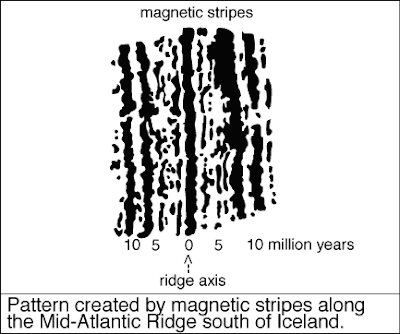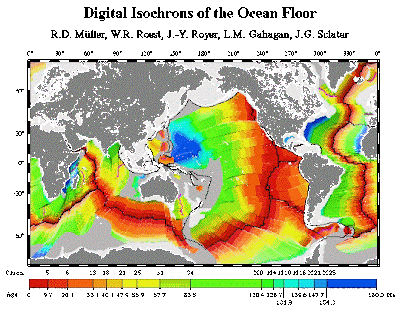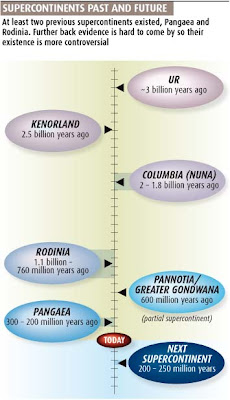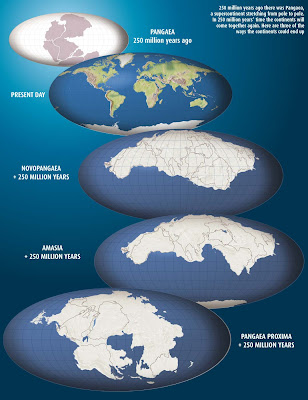OK, here is the capsule history of the Earth. The abbreviation Ma refers to "Mega-annum" or million years in the past, and Ga refers to "Giga-annum" or billion years in the past. I'll add the word "future" for future times:
- ~4.8 Ga: Solar system formed. Earth and other planets begin to form from dust and other junk surrounding the proto-Sun.
- ~4.5Ga: Beginning of Hadean era. Earth is molten throughout.
- ~4.4 Ga: Radioactive-isotope age of the oldest minerals and rocks.
- ~4 Ga: By this time, the crust has differentiated into lighter "continental" granitic rocks and denser "oceanic" basaltic rocks. This implies copious water was present.
- 3.47 Ga: The earliest "chemical fossils", durable organic chemicals that are produced by cyanobacteria (the first photosynthesizing organisms). Coincidentally, the "rusting of Earth", the earliest Banded Iron formations, began at this time.
- 2.3-1.9 Ga: The "rusting" event slows and stops, and Oxygen in the atmosphere rises from less than 1% to about 15%. The continents reached nearly their maximum total volume, and a combined supercontinent has formed; there may have been one or two slightly smaller ones earlier. Others would follow, because plate tectonics is now well under weigh.
- ~1 Ga: The first "somewhat well characterized" supercontinent comes together, called Rodinia from the Russian for Motherland. This is probably between the fifth and tenth supercontinent to form since ~2.5Ga.
- ~0.4Ga or 400 Ma: Formation of Pangea (or Pangaea), the most recent supercontinent.
- 250 Ma: Breakup of Pangea, first in to Gondwanaland in the south and Laurasia in the north. The Permian "great extinction" may be a consequence of the breakup.
- Today: There are seven Continents, and people on them to wonder how they came about (very few folks, admittedly, do so).
- 250 Ga future: Formation of the next supercontinent, called variously Novopangea, Amasia, and Pangea Proxima (among others).
- ~500 ma future: Probably, the continents will be well-scattered, as all but Eurasia are today.
- ~1 Ga future: Another supercontinent. But things may be slowing down.
- ~5 Ga future: It is likely that radiogenic heating in the mantle has dropped to a quarter or less of today's figure, but the solid inner core is probably still releasing plenty of heat as it grows (at the expense of the liquid outer core). If it has grown fast enough, and too little core liquid remains, Earth's magnetic field will nearly disappear, sustained only by remanent magnetism in "recent" rocks. The point is moot, however, because the Sun is about to become a Red Giant, and will reheat Earth to a near-Hadean condition. End of Earth as a life-bearing planet.
The understanding that Pangea was preceded by Rodinia, and that supercontinents tend to form and break up on a cycle of half a billion years, has naturally led a few scientists to project the cycle into the future. How can a future configuration of continents be projected? The primary method is to extrapolate present trends and their past rates. It is particularly important to discern what is constant (e.g. the gravitational constant), what is cyclic (e.g. seasons and orbits), and what changes steadily (e.g.Sun's increasing brightness, or decay of radioactive substances).
 Plate tectonics encompasses all the theories and evidence of the Earth system. Though the term "Earth system" is most frequently used by meteoroligists, it is a geophysical term (geophysics encompasses meteorology).
Plate tectonics encompasses all the theories and evidence of the Earth system. Though the term "Earth system" is most frequently used by meteoroligists, it is a geophysical term (geophysics encompasses meteorology).Visible evidence that clearly points to plate tectonic processes is rather hard for non-Geologists to come by, but the advent of Google Maps makes it easier in at least one instance. Go there and in the search box enter Djibouti, then zoom out a few steps, and click the "Satellite" button. You'll see something like this image (click on it for a much larger view).
The city of Djibouti is near the center of the most visible Triple Junction on the planet. If you spread a few inches of moist sand on a blanket with a large balloon under it (connected to an air hose), then slowly inflate the balloon, the sand will usually crack open in a 3-armed split. Northeast and northwest of Djibouti, the Gulf of Aden and the Red Sea form two arms of such a split. The East African Rift, which passes just east of Adis Abebe (Addis Ababa on older maps) is the third.
The dark blue-to-black physiography for the ocean floors show that both seas harbor rifts down their middles. East Africa is splitting off from the rest of the continent. On your Google map, drag around to see the rift system that underlies all oceans. It is particularly striking under the Atlantic Ocean.
What is happening? At the center of a rift, magma rises from time to time, forming new oceanic crust. Follow along a plate away from a rift (you may need to cross a continent), and you'll find either a trench (e.g. off the coast of South America or Japan) or a new mountain range such as the Himalayas.
Nice thing about oceanic basalt: it contains lots of magnetic minerals. They record the orientation of Earth's magnetic field as they cool down and solidify. Nice thing about Earth's magnetic field: it reverses direction a couple times per million years.
 This image from the USGS shows the stripes recorded by a magnetometer as ships crisscrossed a rift in mid-ocean. The entire ocean floor is like a huge tape recorder. It is a lot like reading tree rings to see the age of the tree, and the rate at which it grew.
This image from the USGS shows the stripes recorded by a magnetometer as ships crisscrossed a rift in mid-ocean. The entire ocean floor is like a huge tape recorder. It is a lot like reading tree rings to see the age of the tree, and the rate at which it grew.Correlating the stripe pattern with fossils (which litter the ocean floor) and radiometric dates from samples gives us the timing and direction of plate motions for the past 180 Ma.
 "Only 180 million years?" you might ask, "Is that all?" Yes, that is all. Older ocean floor has all been consumed by subduction into trenches, though a few small (city- or county-size) pieces have been "obducted" on top of continental crusts, forming "ophiolite belts" such as the Franciscan sequence in northern California.
"Only 180 million years?" you might ask, "Is that all?" Yes, that is all. Older ocean floor has all been consumed by subduction into trenches, though a few small (city- or county-size) pieces have been "obducted" on top of continental crusts, forming "ophiolite belts" such as the Franciscan sequence in northern California.Reading the ocean floor allows us to rewind continental motions back in time to the Jurassic, at 180 Ma, with some confidence. Earlier motions have to be determined from magnetic materials of known age on land, and finding such rocks that are still lying horizontally and undisturbed, is a conundrum! My major professor in graduate school has given his life to finding such rocks, and has a "second office" next to his, lined with a double layer of metallic sheeting to screen out Earth's magnetic field so he can plunk a rock into a magnetometer-goniometer and measure its tiny magnetic field.
Dr. Nield explains all the lines of evidence that let us piece together Pangea, and that give us some idea of the configuration of Rodinia and other compounded continents of the past billion years.
 This illustration from a Hungarian web site sketches the timing of known and inferred supercontinents of the past. There may have been several others; we don't yet have sufficient evidence to determine. However, we do know that supercontinents form in two ways: Introversion and Extroversion.
This illustration from a Hungarian web site sketches the timing of known and inferred supercontinents of the past. There may have been several others; we don't yet have sufficient evidence to determine. However, we do know that supercontinents form in two ways: Introversion and Extroversion.These do not refer to personality types, at least not to a geophysicist. Introversion refers to a supercontinent's pieces slowing and stopping, then pulling back together into much the same configuration as before. Extroversion refers to the pieces continuing right around the planet until they collide on the opposite side, with the new continent's center formed by the outer edges of the earlier one. And...there's more than one way to put either type together.
 From the same site as the image above, this illustration shows three competing projections of the composition of the next supercontinent. Novopangaea and Amasia (It'll amaze ya!) are alternative Extroversion models by Roy Livermore (see the Future is Wild™, which mainly speculates about the critters one might find there). Pangaea Proxima is an Introversion scenario favored by Christopher Scotese (see his Paleomap Project, which includes a nice animation of the Inversion motions).
From the same site as the image above, this illustration shows three competing projections of the composition of the next supercontinent. Novopangaea and Amasia (It'll amaze ya!) are alternative Extroversion models by Roy Livermore (see the Future is Wild™, which mainly speculates about the critters one might find there). Pangaea Proxima is an Introversion scenario favored by Christopher Scotese (see his Paleomap Project, which includes a nice animation of the Inversion motions).Will there be humans, or similarly brainy creatures, living on Novopangaea (or whatever they might call it)? Further on, will plate tectonics come to an end, as it did very early on for Venus, which didn't retain enough water to keep its mantle "only" as "fluid" as stainless steel? Will the inner Earth cool enough for the process to grind to a halt before the Sun takes a whack at re-melting the planet? It is very unlikely that any of our descendants will be there to find out for sure.



1 comment:
hey, is this blog still active?
Post a Comment